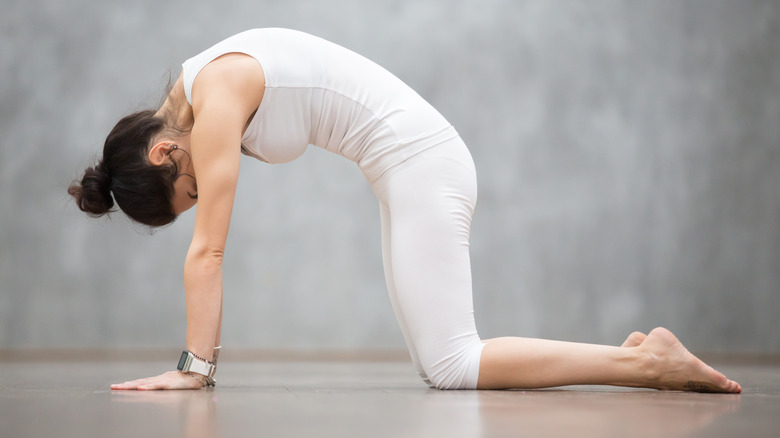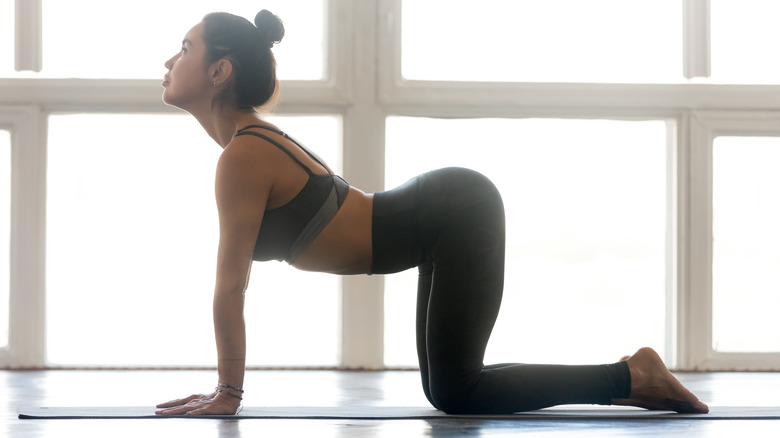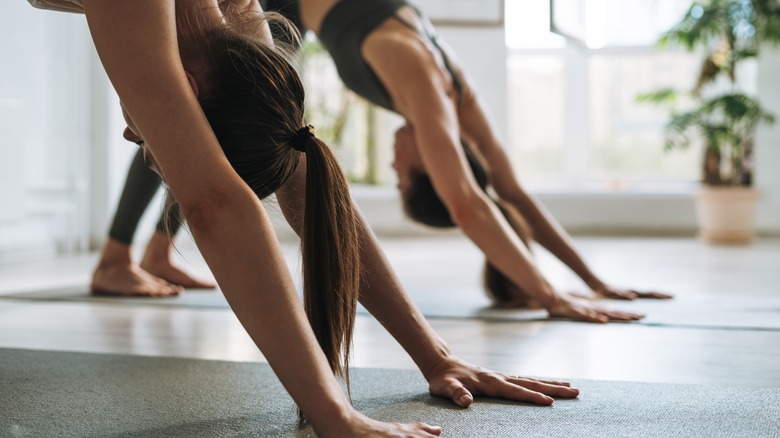Are You Doing The Cat-Cow Yoga Pose Correctly?
Starting a new exercise regimen can become overwhelming, with scheduling time to complete the exercise and learning a new routine. Many individuals seek out enjoyable activities to help boost their daily activity levels — however, some fitness activities can be more challenging to take on than others. This can be particularly true if you're not familiar with the poses, moves, or actions that a new exercise can include. Activities like Zumba, dance fitness, and even Bungee workouts can be challenging due to their complex combinations of movement and equipment. While great for cardio and muscle strength, these types of activities can be intimidating, leaving those less-than-frequent gym goers looking for something a little bit slower paced.
Yoga is a great option for individuals who are looking to increase their daily activity in a low impact manner. In fact, aside from being a great means of adding some movement to your life, yoga has been touted to have a number of benefits for regular practitioners, as explained by Heathline. But occasionally the poses can seem a bit complicated. Here's some advice to alleviate any concerns you may have about doing one popular pose correctly — the cat-cow pose.
The Cat-Cow Pose
While there are a number of different yoga poses, two popular poses used in both traditional yoga and seated yoga are the cat and cow poses. For many yoga practices, these two movements are combined into one flow, called cat-cow. The cat-cow flow is a great way to give your spine a bit of a stretch and relieve some of the tension that is often held in the back, according to Women's Health.
The cat-cow flow is traditionally done in a position where the individual is on their hands and knees. It is important to ensure that in this position, the wrists are in alignment with the shoulders and the knees are directly in alignment with the hips. The cow part of the flow begins by inhaling and dropping the belly towards the mat, tilting the hips, and lifting the head towards the sky or ceiling (via Healthline). For the cat flow, the back is arched upwards while the hips are tilted in and the head is lowered between the shoulders as you exhale. A variation of this flow is also available in a seated position, where the back and shoulders are arched forward for cow pose and backward for cat pose (via Yogapedia).
In both variations, when done properly, you should feel a gentle to moderate stretch in the back, abdomen, and shoulders. Improper form can cause pain, so if you're feeling more than a deep stretch, you may need to reconfigure your body alignment.
Benefits of yoga
So what are the benefits of choosing yoga as part of your workout regime? First, and probably most importantly, engaging in daily yoga practices can help to improve your flexibility. According to Heathline, even the lowest impact yoga practices show influence on the flexibility of the individual. You may be surprised that improving your flexibility can have an overall positive impact on your physical fitness. The Mayo Clinic explains that in addition to reducing the risk of injury, improved flexibility helps improve blood flow, aids in muscle performance, and encourages a fuller range of motion in your joints. Yoga is also reported to provide assistance with stress relief, reducing anxiety, and overall mental health (via Healthline). Other benefits can include improved cardiovascular performance, a boosted immunity, and even better balance.
Yoga is commonly viewed as a lower-risk exercise activity that is often preferred due to the low impact and chance of injury. However, while yoga is a relatively safe activity, special considerations should be considered to avoid aggravating an old injury or causing new injuries. Healthline explains that compared to other forms of exercise, yoga can have the same level of risk for injury and sprain. One way to help avoid injury is respecting your body's limitations, as well as working with a trained instructor who can help you modify exercises where necessary.



